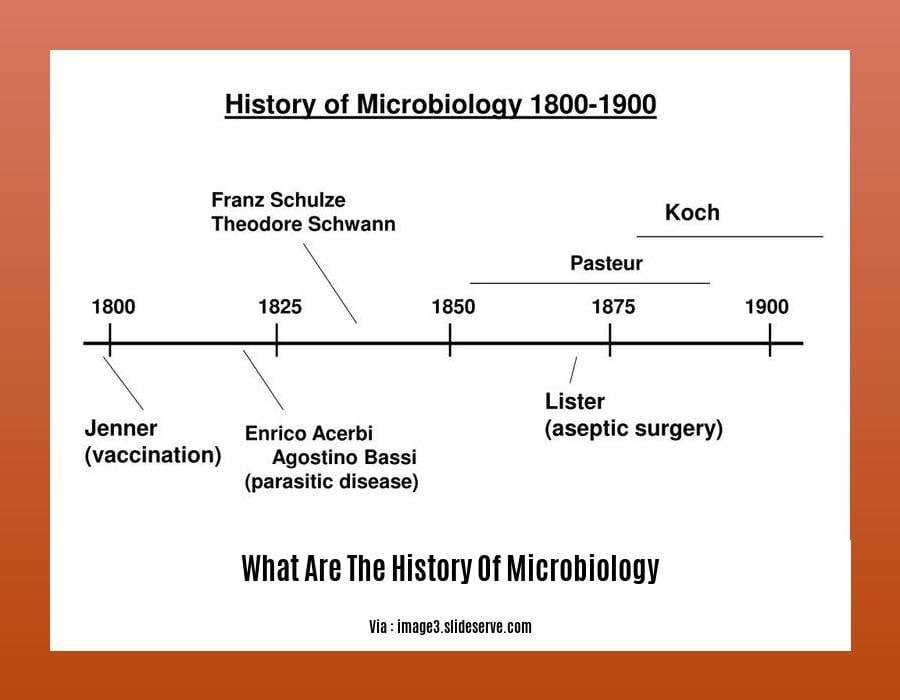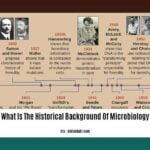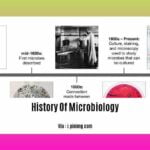Embark on a captivating journey through the annals of microbiology in [What Are The History Of Microbiology: A Journey Through Microbial Discoveries and Advancements]. Delve into the remarkable odyssey of scientific exploration that has unveiled the intricate world of microorganisms, shaping our understanding of life on Earth and beyond.
Key Takeaways:
1674: Antoni van Leeuwenhoek discovered microorganisms using a microscope.
Microbiology developed through microscopic observations, especially for bacteria study.
The 20th century saw the field’s flourishing, but the 19th century contributed to practical issues in fermentation and medicine.
Spallanzani, Pasteur, Cohn, and Koch made significant contributions to microbiology’s advancement.
Leeuwenhoek discovered microbes, while Hooke described live processes under a microscope.
Spallanzani and Pasteur proved that microbial life doesn’t arise spontaneously.
Cohn established the basis for identifying and categorizing microorganisms.
Microbiology expanded from infectious diseases to diverse practical applications.
Challenges include antibiotic resistance, human microbiome exploration, and emerging infectious diseases management.
Microbiology branches include medical, industrial, environmental, and food microbiology.
Bacteria cause diseases by invading the host, producing toxins, and damaging tissues.
What Are The History Of Microbiology
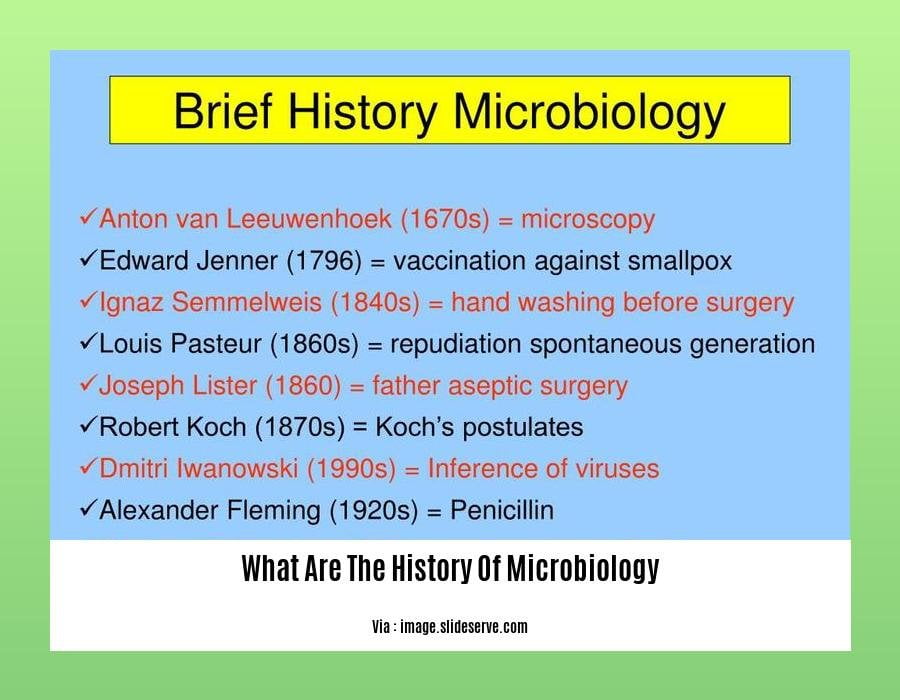
For centuries, the invisible world of microorganisms remained a mystery, shaping our understanding of life on Earth. It wasn’t until the advent of the microscope and the groundbreaking work of pioneering scientists that the field of microbiology emerged, unveiling the intricate world of microbes.
A Glimpse into the Microbial Realm
In 1674, Antoni van Leeuwenhoek’s observations through a microscope marked a pivotal moment in history. He observed tiny living organisms in water, which he called “animalcules,” opening up a new frontier in the study of life. His discoveries revolutionized our understanding of the microbial world, challenging long-held beliefs and paving the way for future advancements.
Exploring the Microbial World: Key Players
The 19th and 20th centuries witnessed a surge in discoveries and breakthroughs in microbiology. Notable figures like Spallanzani, Pasteur, Cohn, and Koch made significant contributions, shaping the field’s trajectory.
Spallanzani and Pasteur: Through their meticulous experiments, they disproved the theory of spontaneous generation, demonstrating that microbial life originates from pre-existing microorganisms.
Cohn: His work laid the foundation for identifying and categorizing microorganisms, establishing a systematic approach to understanding their diversity.
Koch: His postulates, known as Koch’s postulates, became the cornerstone of medical microbiology, providing a framework for linking specific microorganisms to specific diseases.
From Disease to Applications: The Evolution of Microbiology
Microbiology’s reach extends beyond the realm of infectious diseases. It encompasses diverse branches, each contributing to our understanding of the microbial world and its impact on our lives.
Medical Microbiology: Unraveling the mechanisms of infectious diseases and developing innovative treatments have saved countless lives.
Environmental Microbiology: Studying the role of microorganisms in ecosystems and their impact on the environment has shed light on biogeochemical cycles and climate change.
Industrial Microbiology: Harnessing the power of microbes in industries like fermentation, pharmaceuticals, and waste treatment has revolutionized various sectors.
Food Microbiology: Ensuring food safety and preserving the quality of our food supply are critical roles played by food microbiology.
Embracing Future Challenges
The field of microbiology continues to grapple with evolving challenges that require ongoing research and collaboration.
Antimicrobial Resistance: The rise of superbugs resistant to antibiotics poses a serious threat, necessitating the development of novel antimicrobial strategies.
Human Microbiome Exploration: Unveiling the complexity of the human microbiome and its impact on our health opens up new avenues for disease prevention and treatment.
Emerging Infectious Diseases: The rapid emergence of novel pathogens highlights the need for preparedness and surveillance to prevent future pandemics.
As we delve deeper into the microbial realm, we continue to uncover its intricate complexities and profound impact on life on Earth. From its historical roots to its diverse applications, microbiology remains a dynamic field, shaping our understanding of the world and driving innovations that benefit humanity.
Dive into the enigmatic realm of microbiology, where the origin of life, the historical background, and the scope prevail. Embark on a journey through the history of microbiology, unraveling the chronicles of discoveries that have shaped our understanding of the microbial world. Delve into the historical background of microbiology, exploring how the early pioneers laid the foundation for our current knowledge about microbes. Unveil the history and scope of microbiology, illuminating the vast panorama of applications spanning medicine, agriculture, and biotechnology.
Pioneers of Microbiology: Giants of the Field
Picture this: You’re in a battle against invisible foes, microorganisms, that can cause illness, spoil food, and even disrupt entire ecosystems. Who are your allies in this fight? The pioneers of microbiology, the giants who paved the way for our understanding of these tiny life forms.
These trailblazers, armed with their microscopes and insatiable curiosity, embarked on a journey to unveil the secrets of the microbial world. Their discoveries transformed our understanding of life on Earth, revolutionized medicine, and laid the foundation for countless advancements in science and technology.
Key Takeaways:
Antonie van Leeuwenhoek: The “Father of Microbiology,” observed microorganisms for the first time in 1674, opening the door to a whole new realm of life.
Louis Pasteur: Known for his germ theory of disease, he disproved spontaneous generation and developed pasteurization, saving countless lives.
Robert Koch: Coined the term “bacteria” and developed Koch’s postulates, revolutionizing the field of medical microbiology.
Edward Jenner: The father of immunology, developed the smallpox vaccine, pioneering the concept of vaccination.
Alexander Fleming: Discovered penicillin, the first antibiotic, marking a turning point in the fight against infectious diseases.
These pioneers, and countless others, dedicated their lives to understanding and harnessing the power of microorganisms, shaping the world we live in today. Their legacy continues to inspire scientists and researchers, driving advancements that will undoubtedly shape the future of microbiology and its impact on our lives.
Landmark Techniques and Technologies: Advancing Our Understanding
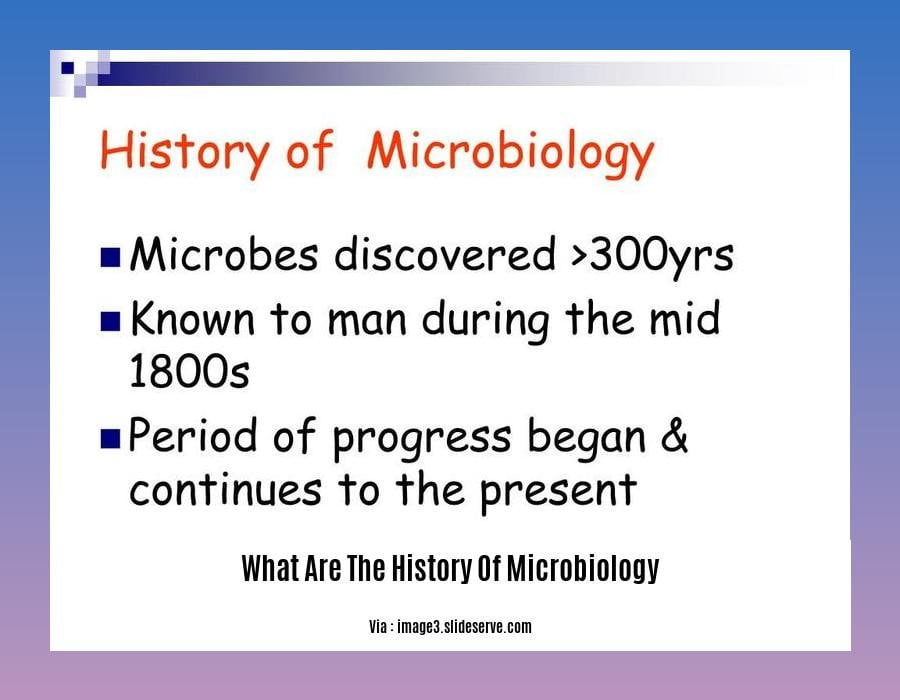
Hey there, folks! Get ready for a fascinating journey through the annals of microbiology. We’ll delve into the groundbreaking techniques and technologies that have revolutionized our understanding of the microscopic world. From the first peep through a microscope to the latest gene-sequencing marvels, we’ll uncover the stories of the pioneers who pushed the boundaries of this captivating field. Buckle up, dear readers, as we embark on an exploration of the historical milestones that brought us to today’s cutting-edge microbiology.
Key Takeaways:
Microscopic Explorations: Antonie van Leeuwenhoek’s pioneering observations using a microscope opened our eyes to the realm of microorganisms, forever changing our perception of life on Earth.
Challenging Beliefs: Scientists like Spallanzani and Pasteur challenged prevailing notions of spontaneous generation, setting the stage for the germ theory of disease.
Classification and Identification: Ferdinand Cohn’s systematic approach to classifying bacteria laid the foundation for understanding their diversity and role in various processes.
Koch’s Postulates: Robert Koch’s rigorous criteria for establishing a causal link between microorganisms and disease revolutionized medical microbiology.
Landmark Discoveries: The identification of penicillin by Alexander Fleming and the development of vaccines by Edward Jenner marked significant milestones in the fight against infectious diseases.
Microbial Genetics: The discovery of DNA as the genetic material and the subsequent advancements in molecular biology have unlocked the secrets of microbial life.
Technological Advancements: The development of new technologies, such as electron microscopes, PCR, and DNA sequencing, has enabled us to delve deeper into the microbial world.
Interdisciplinary Collaborations: The convergence of microbiology with other disciplines, such as genomics, bioinformatics, and immunology, has led to a more comprehensive understanding of microbial processes and their impact on health and the environment.
Examples of Landmark Techniques and Technologies:
| Technique/Technology | Year | Scientist | Impact on Microbiology |
|---|---|---|---|
| Microscopy | 1674 | Antonie van Leeuwenhoek | Enabled the observation and study of microorganisms, leading to the discovery of bacteria and other microbes. |
| Pasteurization | 1864 | Louis Pasteur | Developed a heat treatment process to kill harmful microorganisms in food and beverages, revolutionizing food preservation and safety. |
| Germ Theory of Disease | 1860s | Louis Pasteur, Robert Koch | Established the link between microorganisms and disease, laying the foundation for modern medical microbiology. |
| Koch’s Postulates | 1882 | Robert Koch | Developed a set of criteria to establish a causal relationship between a microorganism and a specific disease. |
| Antibiotics | 1928 | Alexander Fleming | The discovery of penicillin, the first antibiotic, marked a turning point in the treatment of infectious diseases. |
| DNA Structure | 1953 | James Watson, Francis Crick | The discovery of the double helix structure of DNA revolutionized our understanding of genetics and heredity. |
| PCR (Polymerase Chain Reaction) | 1983 | Kary Mullis | Developed a technique to amplify specific DNA sequences, enabling rapid and sensitive detection of microorganisms. |
Sources:
– Microbiology: past, present and future | Nature Reviews Microbiology
– Next-Generation Sequencing Technology: Current Trends and Applications
Applications of Microbiology: Impact on Fields and Society
From food production to medicine, the world of microbiology has left an enduring impact on various fields and society as a whole. Let’s delve into the annals of microbiology to uncover how these tiny organisms have shaped our lives:
Medical Microbiology: A Lifesaving Alliance
Microbiology has revolutionized the medical field, transforming our understanding of infectious diseases and paving the way for groundbreaking treatments. The discovery of microorganisms as the root cause of infections led to the development of vaccines and antibiotics, dramatically reducing the incidence and severity of infectious diseases like smallpox, polio, and tuberculosis.
Environmental Microbiology: Guardians of Our Planet
Microorganisms play a pivotal role in maintaining the delicate balance of our ecosystems. They contribute to nutrient cycling, waste decomposition, and the removal of pollutants from air, water, and soil, ensuring a clean and sustainable environment for generations to come. Their impact extends to agriculture, as soil microbes aid in plant growth and nitrogen fixation, enhancing crop yield and reducing the need for chemical fertilizers.
Industrial Microbiology: Harnessing Microbial Might
Microorganisms are nature’s tiny workhorses, utilized in various industrial applications. In the food industry, they ferment beverages, produce biofuels, and create enzymes for food processing. In the pharmaceutical industry, they manufacture antibiotics, vitamins, and other essential medicines. By harnessing the power of microbiology, industries can create sustainable and eco-friendly products, reducing waste and environmental impact.
Food Microbiology: Ensuring Safe and Nutritious Fare
Microorganisms play a crucial role in food production and safety. They enable fermentation processes, extending the shelf life of foods and creating delectable flavors in fermented products like cheese, yogurt, and alcoholic beverages. Additionally, food microbiology ensures food safety by detecting and eliminating harmful microorganisms, preventing foodborne illnesses.
Key Takeaways:
- Medical Microbiology:
- Revolutionized infectious disease treatment through vaccines and antibiotics.
- Environmental Microbiology:
- Maintains ecosystem balance, aids in nutrient cycling, and removes pollutants.
- Industrial Microbiology:
- Used in various industries for food processing, biofuel production, and pharmaceutical manufacturing.
- Food Microbiology:
- Enables fermentation, extends shelf life, and maintains food safety.
Sources:
- Microbiology and Society
- The Role of Microorganisms in the Environment
FAQ
Q1: Who is considered the “Father of Microbiology”?
A1: Antoni van Leeuwenhoek, a Dutch scientist, is widely regarded as the “Father of Microbiology” for his pioneering observations of microorganisms using a microscope in the 17th century.
Q2: What significant contributions did Louis Pasteur make to microbiology?
A2: Louis Pasteur, a French chemist and microbiologist, played a crucial role in advancing microbiology in the 19th century. He conducted groundbreaking experiments demonstrating that microbial life does not arise spontaneously and developed the process of pasteurization, which revolutionized food preservation and public health.
Q3: How did Robert Koch contribute to the field of microbiology?
A3: Robert Koch, a German physician and microbiologist, made significant contributions to microbiology in the late 19th century. He developed techniques for isolating and culturing bacteria, including the famous “Koch’s postulates,” which established criteria for identifying the causative agents of infectious diseases.
Q4: What is the significance of the Golden Age of Microbiology?
A4: The Golden Age of Microbiology refers to a period of rapid advancements in the field during the late 19th century. This era witnessed the discovery of germ theory, the development of pasteurization and sterilization techniques, and the identification of key pathogens responsible for infectious diseases.
Q5: How has technology influenced the progress of microbiology?
A5: Technological advancements have been instrumental in推动ing the progress of microbiology. Improvements in microscopy, culturing techniques, genetic sequencing, and computational tools have enabled researchers to study microorganisms in greater detail, leading to breakthroughs in understanding microbial diversity, pathogenicity, and potential applications in various fields.
